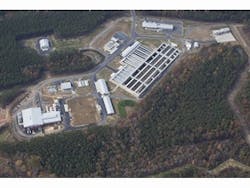The Western Wake Partners constructed the Western Wake Regional Water Reclamation Facility (WWRWRF) with the region’s future growth in mind. The facility is located in North Carolina’s Research Triangle region, a part of the United States that has seen tremendous residential and economic growth. The plant, operated after construction by the Town of Cary, treats to strict nitrogen and phosphorus standards for both permitted discharge to the Cape Fear River and for reclaimed use at the plant. The WWRWRF produces Class A, exceptional quality biosolids.
The WWRWRF’s biological treatment process is an advanced five-stage process for biological removal of nitrogen and phosphorus followed by secondary clarifiers. The clarified effluent flows by gravity to Hydrotech Discfilters. The downstream disinfection process is ultraviolet. Sludge is dewatered with belt filter presses and then dried with Kruger BioCon dryers. The final Class A end product is sold and transported offsite by an outside vendor and applied as an agricultural soil amendment.
The Solution
Kruger supplied eight HSF2220-2F Hydrotech Discfilters, along with PLC controls and required field services. The system is designed to an effluent total suspended solids (TSS) of less than or equal to 5 mg/L based on the peak hourly flow with a peak influent TSS of 20 mg/L and an average TSS of 10 mg/L.
Kruger was selected as the filtration equipment provider because of the maintenance and operational advantages of the Discfilter system. In addition, the Hydrotech Discfilter has a record of being a reliable filtration technology.
Kruger’s scope of supply included two wet sludge cake silos, two BioCon dryers, a dry product handling and storage process—including a pelletizing and screening system—and an inert gas and dust collection system. Two dryers will initially operate in an alternating manner. As flows increase, the two dryers will eventually function as two full-time parallel units.
Kruger supplied a two-dryer system capable of evaporating 7,600 lb of water/hr. For this plant, this means that this is about 1,370 dry lb of sludge/hr. The plant’s current lower loading is 3 dry tons/day. The build-out capacity is 14 dry tons/day.
In addition to the sludge dryers, Kruger supplied an end-product particle-sizing system and dried product storage silos. The end product is shaped to a required density and size using this system and then conveyed to the two silos located outside the biosolids building. These silos are emptied into a transport truck as often as needed, and the dried pelletized end product is hauled away. The facility has made arrangements to have a third-party nutrient management company purchase the pelletized end product.
The Western Wake Partners had two main objectives when developing the biosolids portion of the plant: safety and end-product quality. Maintaining a safe environment was a priority, which is one of the main reasons the BioCon belt dryer technology was selected. Also, the ability to sell the end product as a fertilizer within the local community reinforced the partners’ commitment to sustainability. This drove the pelletizer design of the BioCon.
The Results
Kruger has provided the Western Wake Partners, including the Town of Cary, with a complete and fully automated dryer and end-product handling system. This solution will serve to not only minimize the amount of sludge to be removed, but also allow the facility to produce a desirable and marketable end product.



